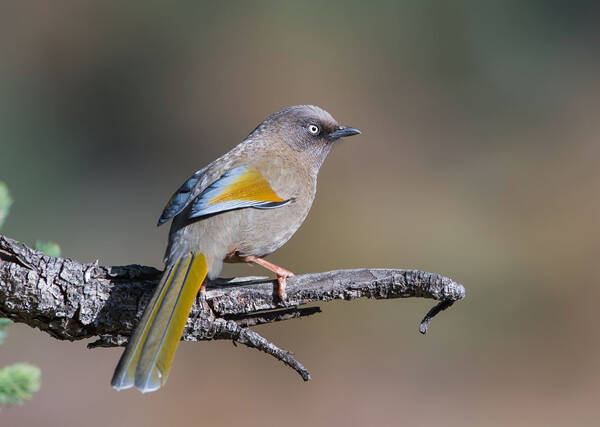Trochalopteron elliotii
IUCN
LCBasic Information
Scientific classification
- name:Trochalopteron elliotii
- Scientific Name:Trochalopteron elliotii,Elliot's Laughingthrush,Garrulax elliotii (Verreaux, 1870)
- Outline:Songbird
- Family:Passeriformes Laughingthrush Glechotidae
Vital signs
- length:20-29cm
- Weight:49-75g
- lifetime:About 10 years
Feature
The outer tail feathers are green with orange-yellow edges and white tip spots.
Distribution and Habitat
Endemic to central China, southeastern Tibet and northeastern India. Distribution: The nominate subspecies is found from Daba Mountain, Qinling Mountains and Min Mountain southward to western Sichuan, southeastern Tibet and northwestern Yunnan. The Qamdo subspecies is distributed from the Qilian Mountains in northern Gansu to eastern Qinghai in the south.
It mainly inhabits mountain and plateau forests and thickets at an altitude of 1500-3400 meters. In Tibet, it is even distributed in mountain thickets at an altitude of 4200 meters. It also inhabits willow thickets, honeysuckle thickets, rhododendron thickets and square-branched cypress thickets in open areas such as forest edge sparse forest thickets, bamboo thickets, farmlands and stream sides.
Appearance
The plumage of male and female orange-winged thrush is similar. The forehead, top of the head and back of the neck are deep grape gray or sandy brown, the forehead is lighter and nearly sandy yellow, and the rest of the upper body, including the wing coverts, is olive brown or gray olive brown, and some are close to yellow brown. The flight feathers are dark brown, the outer vanes of the outer flight feathers are light blue-gray or silver-gray, and the base is orange-yellow, gradually expanding from the outside to the inside to form wing spots, and the outer vanes of the inner flight feathers are similar to the back, and the inner vanes are dark brown. The central tail feathers are gray-brown or golden green, the inner vanes of the outer tail feathers are dark gray, the outer vanes are green with orange-yellow edges, and all tail feathers have white end spots, and the white end spots of the tail feathers are larger as they go to the outside. The front of the eyes is black, the cheeks a
Details
The orange-winged laughingthrush is also known as Elliot's Laughingthrush in English. It has two subspecies.

In 2016, the Orange-winged Laughingthrush (Trochalopteron elliotii) was included in the Laughingthrush family and the "Colored-winged Laughingthrush" (Trochalopteron) from the Garrulaxi genus.
Orange-winged Laughingthrush moves in pairs during the breeding period, and mostly in groups in other seasons. It often jumps, shuttles, or flies in and out among the branches and leaves in the lower part of the bushes. Sometimes it is also seen moving and foraging among the fallen leaves on the ground under the forest, and constantly makes "Guer, Guer" calls, especially in the early morning and evening. The calls are loud and beautiful. After being frightened, it either quickly falls into the depths of the bushes, or flies from one bush to another, and generally does not fly far.
The breeding season of the Orange-winged Laughingthrush is from April to July. It usually nests in the bushes under the forest, and the nests are mostly built on the low branches of bushes or young trees, 0.5-0.7 meters above the ground. The nest is bowl-shaped, and the outer layer is mainly composed of twigs, bark, grass stems, dead leaves and other materials, and the inner pad is made of thin grass stems and grass roots, and sometimes thin vines. The size of the nest is 13.8-20 cm in outer diameter, 8-9 cm in inner diameter, and 5-7 cm deep. Each nest lays 2-3 eggs, which are sky blue or bright blue-green, with sparse dark brown spots on the blunt end. The eggs are oval, 27.5-30 mm × 20-21.4 mm in size, 28.5 mm × 20.8 mm on average, and weigh 5.5-6 grams.
The Orange-winged Laughingthrush is a bird endemic to China, with a relatively abundant population. It is a common type of laughingthrush in southwest China. The species has a wide distribution range and is not close to the critical value of vulnerable and endangered species survival (distribution area or fluctuation range less than 20,000 square kilometers, habitat quality, population size, and fragmented distribution area). The population trend is stable, so it is evaluated as a species without survival crisis.
Listed in the "Red List of Threatened Species of the World Conservation Union" (IUCN) 2016 ver3.1-Least Concern (LC).
Listed in the second level of China's "National Key Protected Wildlife List" (February 5, 2021).
Protect wild animals and eliminate game.
Maintaining ecological balance is everyone's responsibility!








